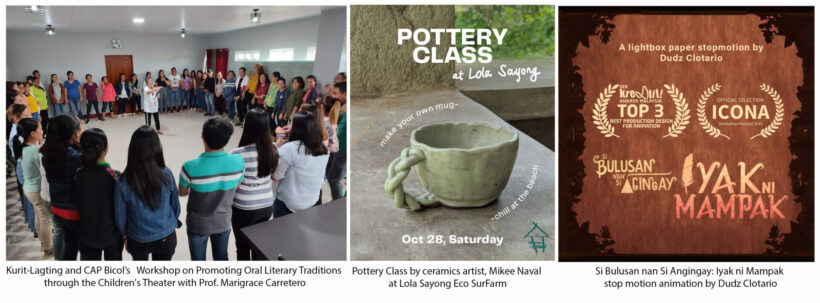by Geri Matthew “Choi” Carretero (Kurit Lagting/ CAP Bicol)
The rich cultural tapestry of the Philippines, found throughout the archipelago, holds unique stories, traditions, and artistic expressions often overlooked on the national stage. For far too long, the vibrant world of Philippine art has been largely centralized in Metro Manila, but thanks to the initiatives of various art groups in Sorsogon, we are witnessing a transformative shift. This transformative shift is happening at a grassroots level, setting the stage for a cultural renaissance.
While the concept of decentralization isn’t new in the Philippine art scene, what’s unfolding in Sorsogon is revitalizing this idea. Driven by the belief that art is intrinsic to society, local art groups are working tirelessly to tap into the province’s creative potential. Their initiatives aim to empower local artists and bring art closer to the community, fostering a culture of appreciation and innovation.
One such initiative focuses on promoting indigenous art forms, ranging from traditional dance, poetry, folktales, community theater, and vibrant woven textiles to intricate ceramics. Artists and art groups are committed to preserving and reviving these traditions, passing them down to future generations through heritage talks, community projects, art fairs, films, and workshops.
Community engagement is pivotal. Art exhibitions, murals, collaborative artworks, and cultural events are held in public spaces, ensuring accessibility for all. Artist-run exhibits, independent galleries, and art spaces are now open to the community, not just the urban elite, allowing underprivileged communities to engage with creativity.

The digital age also plays a significant role in amplifying Sorsogon’s art scene and social issues. Social media and online galleries provide a platform for local artists to share their work with a global audience, granting them visibility and participation in a broader artistic discourse and advocacies.

Decentralization isn’t just about shifting the geographical focus of art; it’s about creating an inclusive and participatory culture of creativity. These local art groups’ initiatives have the potential to reshape the dynamics of the entire Philippine art world, inviting diversity, amplifying unheard voices, and revealing artistic expressions previously hidden in the shadow of the metropolis.
As we celebrate the democratization of art in Sorsogon, it’s essential to acknowledge the challenges and opportunities this transformative journey presents. Both financial and moral support are vital for these initiatives to thrive, and local and national governments should recognize Sorsogon’s potential as a cultural hub and invest in its growth.
Sorsogon’s “art renaissance” illustrates the power of local communities coming together, marking a significant step towards decentralizing and democratizing Philippine art, offering a vision of a more inclusive and diverse cultural landscape.
# # #
About the writer:
Geri Matthew “Choi” Carretero is a Bicolano multidisciplinary artist, independent curator, and community development worker. He is the co-founder of the Kurit-Lagting Art Collective and a member of the Concerned Artists of the Philippines.










